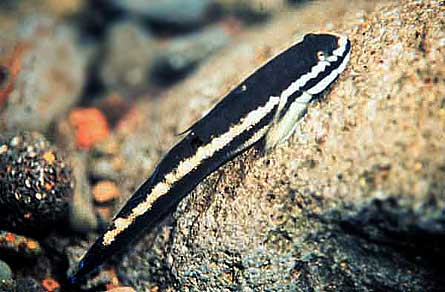Between a rock and a wet place
If you're a fish that climbs waterfalls, is it better to have a squat body, or be tall and a fast swimmer?
 |
|
Hawaii’s climbing gobies use their mouths and a tiny sucker on their undersides to cling to rocks while scaling waterfalls.
|
| Eric Nishibiyashi, TNC |
Life is anything but a vacation for a climbing goby, a small fish that lives in Hawaii. Usually shorter than your thumb, this fish hatches in freshwater high in the hills and mountains. But soon afterward it’s swept out to the salty sea by strong currents.
About six months later, the fish begin the long journey back upstream to freshwater above waterfalls. It’s a good place for climbing gobies to breed because their natural predators — mainly other fish — can’t get to them above the falls.
During its return to the high freshwater streams, a climbing goby faces two deadly challenges. First, the fish has to swim through lowland waterways that are filled with predators — larger fish that are looking for a goby snack. Then, a goby has to climb up rocky waterfalls, some of which are hundreds of feet tall. It clings to the slippery rocks with its mouth and a tiny sucker on its underside. Slowly, inch by inch, the fish climbs. Richard Blob, a scientist a Clemson University who studies gobies, says that “in human terms, it’s like a marathon.”
Gobies of the same species have differently shaped bodies depending on where they live in the Hawaiian islands. Fish in some places are short and squat; others are taller from top to bottom. Blob and a team of scientists recently studied the bodies of climbing gobies to try to understand why this variation in body shape exists.
Blob and his team placed climbing gobies from Hawaii’s Big Island in tanks containing sleeper fish, which prey on gobies. After the sleepers had caught half the gobies, the scientists measured the bodies of the surviving gobies. Those that were able to escape being eaten were taller than average. A taller body allows the fish to swim faster — and thus avoid becoming a sleeper’s dinner.
If more tall-bodied gobies in a fish population survive, then their offspring will probably be tall as well. Thus, the gobies in that area will tend to be tall. But the story is more complicated.
While having a taller body may help a goby avoid predators, it may be a big problem when the fish tries to start climbing. In an earlier study, scientists found that larger gobies struggle more than smaller gobies when trying to make it up a waterfall. Shorter, squatter gobies have an easier time clinging to the rocks and not getting washed away. So, scientists wonder, is it better to have a squat body (to get up the waterfall easier), or a large body (to avoid predators on the way to the waterfall)?
The answer is: It depends on where a climbing goby lives. On the Big Island of Hawaii, where the waterfalls are close to the shore, gobies don’t have to travel far through predator-infested waters. So scientists can expect to find smaller gobies there. But on the island of Kauai, the waterfalls are farther from shore — suggesting that scientists will find more of the larger and faster gobies there.
The story of the goby’s body shape is an example of evolution at work. Evolution is a process taking place in every organism, from gobies to humans. It explains how species change over a long period of time. What the scientists found is that natural selection, one of the basic parts of evolution, is helping to shape the gobies’ different body sizes according to where they live. In natural selection, animals with traits that help them live in their environment will survive and reproduce more than animals with less helpful traits. So in Hawaii, the type of goby you find depends on which island you’re studying.







